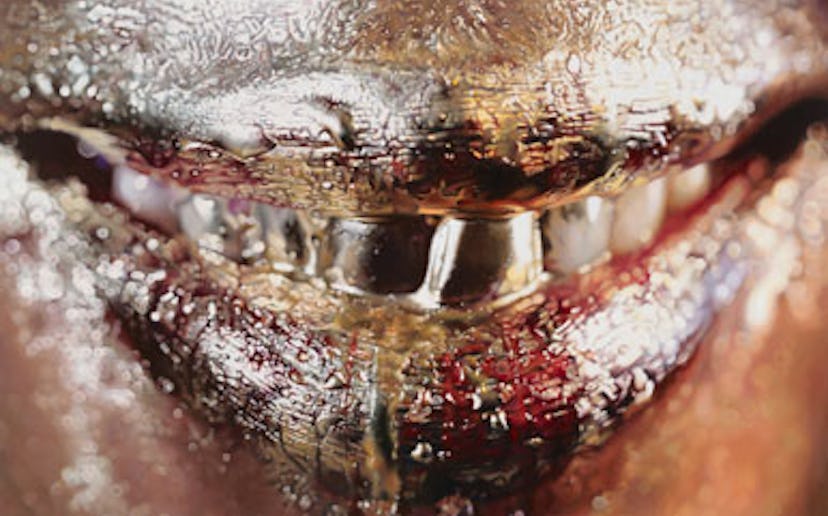Behind The Seen: Eight Questions for Marilyn Minter
Artist Marilyn Minter has worked with degraded ideas of glamour for over 30 years, beginning with the photographs she took in the late ‘60s of her drug-addicted mother. Her recent work collapses the distance between...

Artist Marilyn Minter has worked with degraded ideas of glamour for over 30 years, beginning with the photographs she took in the late ‘60s of her drug-addicted mother. Her recent work collapses the distance between glamour and the grotesque, reflecting back to us our queasy relationship to our own desires. Minter’s current solo show is now on view at Salon 94 until December 4.
Your recent work has incorporated a lot of fetishistic fashion items, like stilettos and lipstick. Do you feel that your work expresses an implicit critique of the way femininity is codified? One of the things I’ve been criticized about is not taking a position, but I do take one. I work with things that are considered debased and shallow, but the reality is that there’d be no Internet without porn and that fashion and beauty are multi-billion dollar industries. To say that they’re superficial is too easy. That’s my position. They give people a lot of pleasure, but at the same time they distort everything…it’s this huge thing in our lives that we pretend is superficial. There’s a paradox because you get a lot of pleasure from looking at these kinds of images but you’re never going to look as good as them. I like things that have multiple readings.
What were some of the ideas that inspired these new paintings? In Green Pink Caviar [Minter’s 2009 video], I used a piece of glass between the subjects and the camera. I began shooting images of very expensive shoes kicking up gold paint using the same technique. I thought it would be interesting to see how it created this abstract space. With the paintings of babies, I wanted to do something similar but with silver paint. Most metallic paints aren’t reflective in their container, but my makeup artist figured out if you suspend the silver paint they use to decorate cakes in vodka with a little glycerin, it creates a great effect.
You’ve worked on campaigns and projects for Tom Ford, MAC, and Jimmy Choo. What is it like to be embraced by an industry (fashion) that could be seen as part of your cultural critique? The fashion world tells me how much they love my work, but they don’t hire me very often. Tom Ford did, and he hated it. Naturally, he wanted to Photoshop away the imperfections, which is perfectly understandable. They want their vision.
What kind of reaction did the porn paintings from the late 80‘s that you exhibited this past spring at Team Gallery prompt when you created them? It was a politically correct time, and I think for women to work with [explicit imagery], it’s still very difficult, because there’s a glass ceiling. My question was: Can a woman artist reclaim work from an abusive history? I thought ‘what subject matter has never been touched by a woman?’ I was, and still am, a second wave feminist, and I believe that no one has politically correct fantasies. It was at the same time that Madonna did her Sex book and she was thrown out of the music world, and I was thrown out of the art world. It wasn’t ok for a woman to make work like that.
How does sensuality or sexuality still figure into your work? I’ve always tried to be very seductive. I want the paintings to draw you in. But I don’t want to just glamour you. I want to make an image of the time we live in and reflect it back. The culture itself informs me of what I should do next
Your inclusion in the 2006 Whitney Biennial catapulted you to another kind of public success. What was this experience like as someone who had been making and exhibiting strong work for decades? I watched artists who blew up before me become parodies of themselves. I wasn’t listening to people when they told me that I had nothing to say, and I can’t listen to people now when they tell me I’m the bomb, even though I want to. Success is really dangerous. I want to be able to hear people when they tell me that something can be better, and it’s hard to do that when you’re getting $3 million per painting.
Do you think the influx of capital into the art world has altered the landscape for better or worse? It’s cyclical. It used to be real estate, and now that 1 percent is buying art. Some people will be fine. If you have already made it to a certain level then you’re fine. But if you’re one of the people in the middle like me, you’re gonna be in big trouble!
What are your thoughts on the voracious appetite for newness that has developed? It’s called progress and I think it’s a good thing. If you really have something to say, sooner or later it will be heard. And if you’re lucky you’ll still be alive.
Visit Salon94 for more information.
Images: Courtesy of the artist and Salon 94, New York.